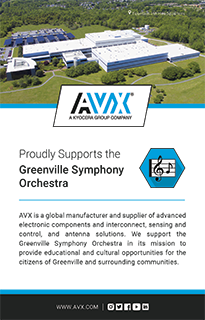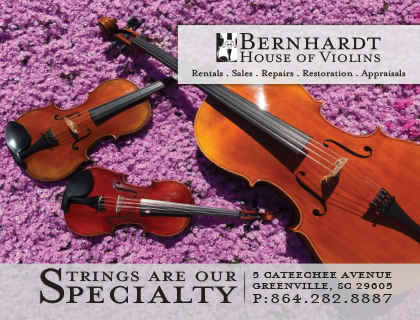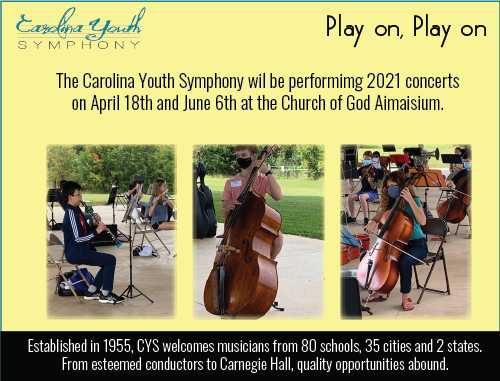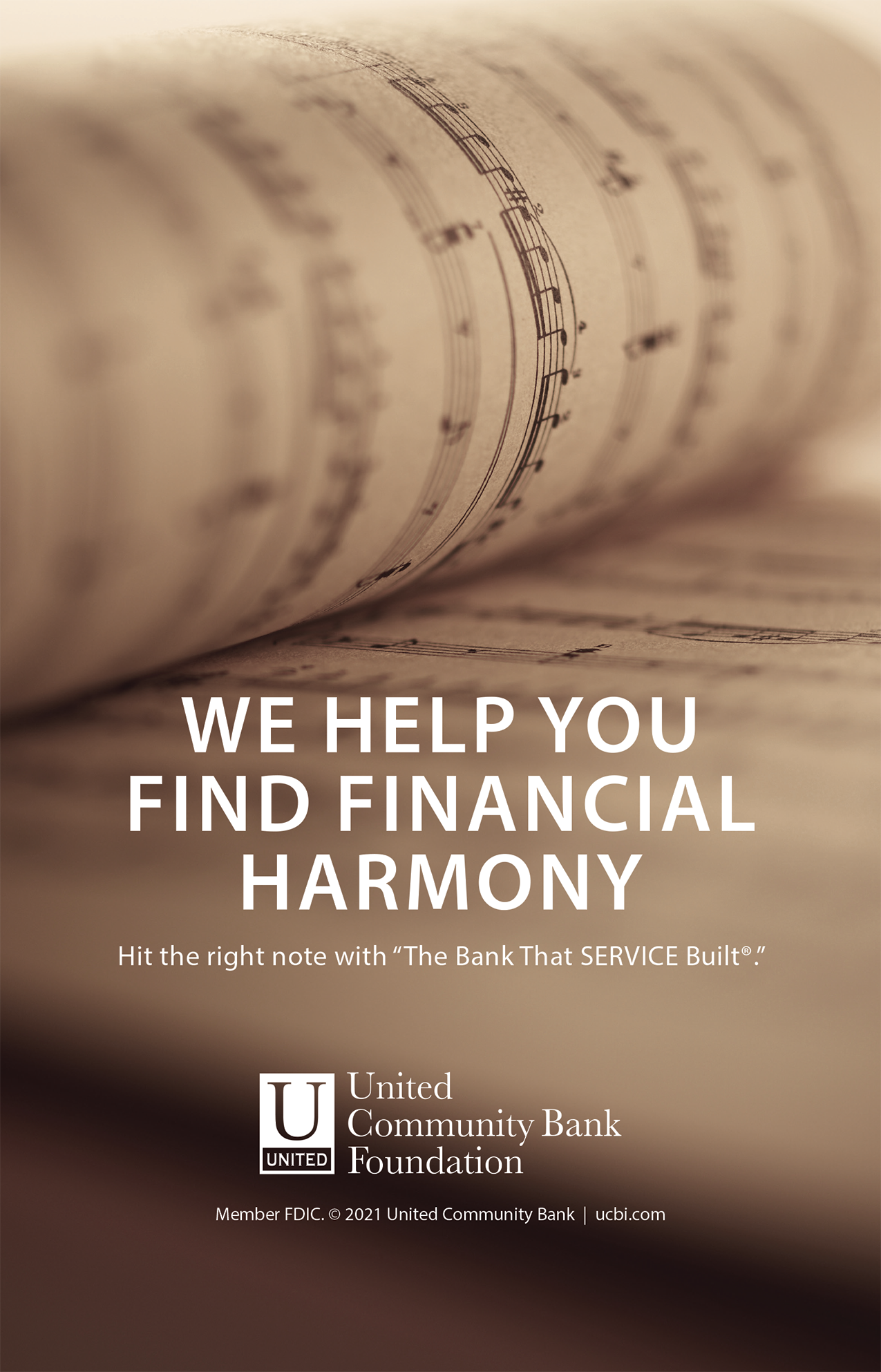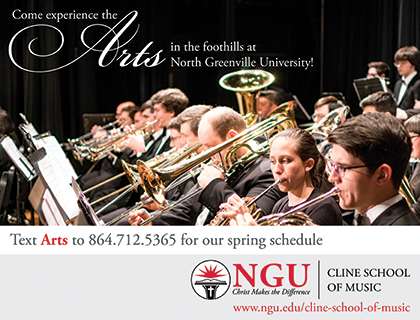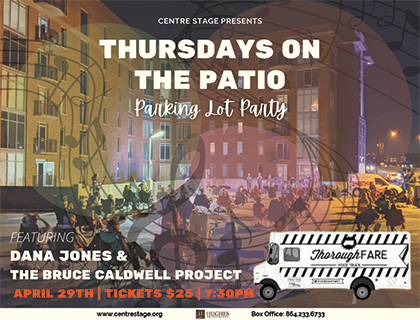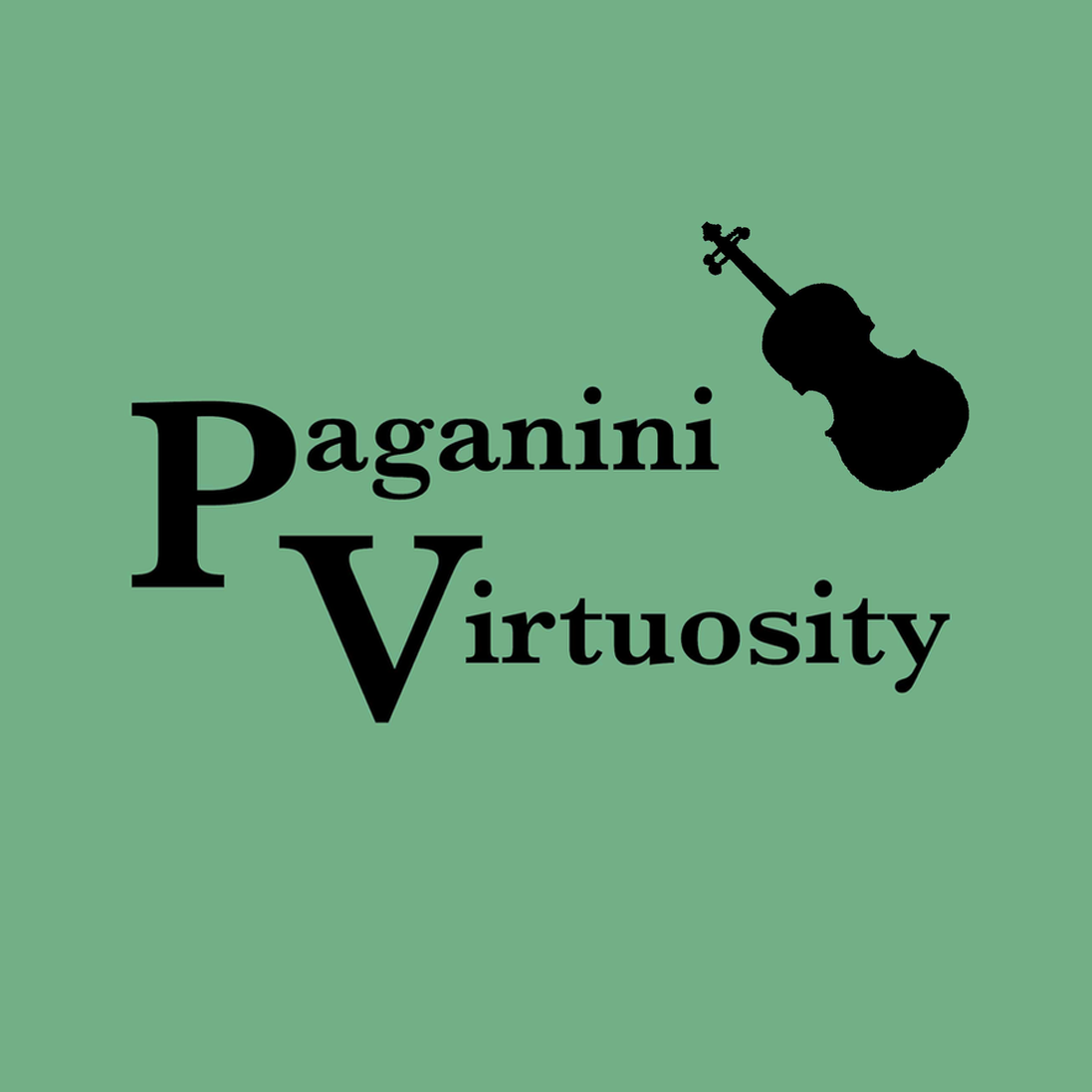
PAGANINI VIRTUOSITY
Saturday, May 15, 2021 at 8:00 p.m.
Sunday, May 16, 2021 at 3:00 p.m.
Peace Concert Hall
Edvard Tchivzhel, conductor
Alexander Markov, violin
|
N. Paganini |
Violin Concerto No. 1 |
| G. Bizet (1838-1875) |
Symphony in C |
This General Operating Support Grant program is funded in part
by the Metropolitan Arts Council with grants received from the City of Greenville, the South Carolina Arts Commission whichreceives support from the National Endowment for the Arts and private donations.
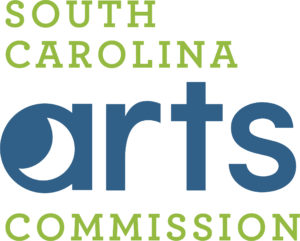
This organization is funded in part by the
South Carolina Arts Commissionwhich receives support
from the National Endowment for the Arts.
VIOLIN
Laura Colgate,
Concertmaster
Leila Cunningham Roe Endowed Chair
Mary Lee Taylor Kinosian,
Assistant Concertmaster
Uwe Diestel Endowed Chair
Inez Hullinger Redman
Xiaoli Saliny
Sarah Land
David Edwards
Robin Hague Els
VIOLIN
Joanna Mulfinger,
Principal
Deidre N. Hutton,
Assistant Principal
Elizabeth Fee
James R. Johnson
Esena Setaro
Catherine Hazan
David Strassberg
VIOLA
Arthur Ross III,
Principal
Erika and Chuck Riddiford Endowed Chair
Emily Schaad,
Assistant Principal
Scott Garrett
Leigh Dixon
CELLO
Ismail Akbar,
Principal
Guild of the Greenville Symphony Endowed Chair
Ryan Knott,
Assistant Principal
David Saliny
Dusan Vukajlovic
DOUBLE BASS
Ian Bracchitta,
Principal
Anonymous Endowed Chair
Todd L. Beal,
Assistant Principal
Jonathan McWilliams
FLUTE
Caroline Ulrich,
Principal
Alice and Jerry Lenz Endowed Chair
Esther Waite
Lauren Watkins Vaughn
OBOE
Virginia Zeblisky Metzger,
Principal
Guild of the Greenville Symphony Endowed Chair
Kelly Mozeik
CLARINET
Anthony Marotta,
Principal
Harriet and Jerry Dempsey Endowed Chair
Taylor Massey
BASSOON
Lauren Piccirillo Waid,
Principal
Anonymous Endowed Chair
Stephanie Lipka
HORN
Anneka Zuehlke-King,
Principal
Charles W. Wofford and Nancy B. Thomas Endowed Chair
Elizabeth Regas
Michael Daly
Darian Washington
TRUMPET
Phil Elkins,
Co-Principal
Beverley and Jim Whitten Endowed Chair
Kevin Lyons,
Co-Principal
Beverley and Jim Whitten Endowed Chair
Gary J. Malvern,
Assistant Principal
Craig King
TROMBONE
Stephen Wilson,
Co-Principal
Michael Hosford,
Co-Principal
Richard deBondt
TUBA
Don Strand,
Principal
TIMPANI
Daniel Kirkpatrick,
Principal
Nancy B. Stanton Endowed Chair
PERCUSSION
Courtney McDonald Bottoms,
Principal
Edward C. Nagel,
Assistant Principal
John Beckford
Gary Robinson
PRODUCTION MANAGER
Laura Auvil
PRINCIPAL LIBRARIAN
John Wickey
Paganini Virtuosity
Program Notes by Paul Hyde
Violin Concerto No. 1
Niccolo Paganini (1782-1840)
Niccolo Paganini sold his soul to the devil in exchange for supernatural musical powers. Or at least that was the legend that followed the 19th century violin virtuoso throughout his entire life.
No other violinist could play with such extraordinary skill and musicality.
Paganini, tall and gaunt, may have encouraged the devilish rumors to enhance his career as a violinist and composer. Sometimes, nothing succeeds like excess in the musical world.
Paganini was a master of the concertos of other composers, but audiences in his time wanted to hear his own compositions. His works include dozens of pieces for solo violin and six violin concertos.
The first of these concertos is the one most often heard in concert halls today. With its lightning-fast scales and arpeggios, the dazzling piece makes considerable demands on the soloist. It includes innovations — complex harmonics and left-hand pizzicato — that made Paganini famous.
- The orchestral introduction presents the first movement’s two main themes. A descending staccato figure in the violins develops into a grand procession for full orchestra. That’s followed by a contrasting lyrical theme in the violins. Paganini’s music seems informed here and elsewhere by the grandeur and singing lyricism of Italian opera. The solo violinist enters offering variations on the first theme with wide melodic leaps and brisk running passages. The soloist then soars sweetly with the second theme. On the whole, however, virtuosic brilliance is the focus of this opening movement.
- The slow movement greatly impressed listeners in Paganini’s time with its poignancy that verges on the tragic. Schubert declared, “In Paganini’s Adagio, I heard an angel sing.” With its plucked string accompaniment, this movement also may remind listeners of Italian opera. Paganini once suggested this movement had been inspired by a tragic prison scene on stage in which one of the greatest Italian actors of his time, Giuseppe de Marini, played the part of a prisoner weeping and praying to heaven for help.
- The melancholy mood is completely dispelled by the arrival of the joyous third movement. The finale is in the form of a rondo, with the main skipping theme toggling with contrasting melodies. The soloist’s virtuosity is again on full display.
Symphony in C
Georges Bizet (1838-1875)
There’s a remarkable story behind this delightful symphony, composed in merely a month when Bizet was only 17 years old. It exhibits all the spontaneity and youthful vigor that one might expect.
Yet Bizet seems to have hidden the 1855 work from view. Still a student at the Paris Conservatory, Bizet might have felt insecure about the piece. Or he feared that it too closely resembled a symphony by his teacher Charles Gounod.
Eighty years later, long after Bizet’s death, the manuscript was found among the composer’s papers at the Paris Conservatory. It received its world premiere in Basel in 1935. Bizet is best known as the composer of the popular opera “Carmen,” but that work’s dramatic and tragic mood is nowhere to be found in this vivacious Symphony in C.
- The first movement seems to leap for joy, with the giddiness of a Rossini overture. The solo oboe, meanwhile, sings a contrasting theme.
- The second movement again spotlights the oboe, with a lonely serenade-like melody with a hint of mystery. That’s followed by a serene theme for strings. After a contrasting middle section, the two main themes return to round off the movement.
- A rustic dance is suggested by the sprightly third movement. In the middle section, the main theme is repeated but against a droning bass suggestive of bagpipes.
- The zesty finale features scampering figures and a sweeping sunlit theme for the first violins.
Paul Hyde, a longtime Upstate journalist, is the public information coordinator for the College of Architecture, Arts and Humanities at Clemson University. Follow him on Facebook (Upstate Onstage) and Twitter: @PaulHyde7.
The Greenville Symphony Orchestra and Maestro Edvard Tchivzhel have announced details of the 2021-22 concert season. Renewal packets for current subscribers are in the mail. Patrons who did not subscribe to the 2020-21 season, but would like to join us next year may call the Peace Center Box office at (864) 467-3000 open 9:30am - 5:30pm weekdays.
Highlights include music of Mozart, Beethoven's mighty "Eroica" Symphony, the thundering "Organ" Symphony of Saint-Saens, plus appearances by local favorites Laura Colgate, David Gross, Zachary Hughes, and International Ballet. A complete list of programs is available here:
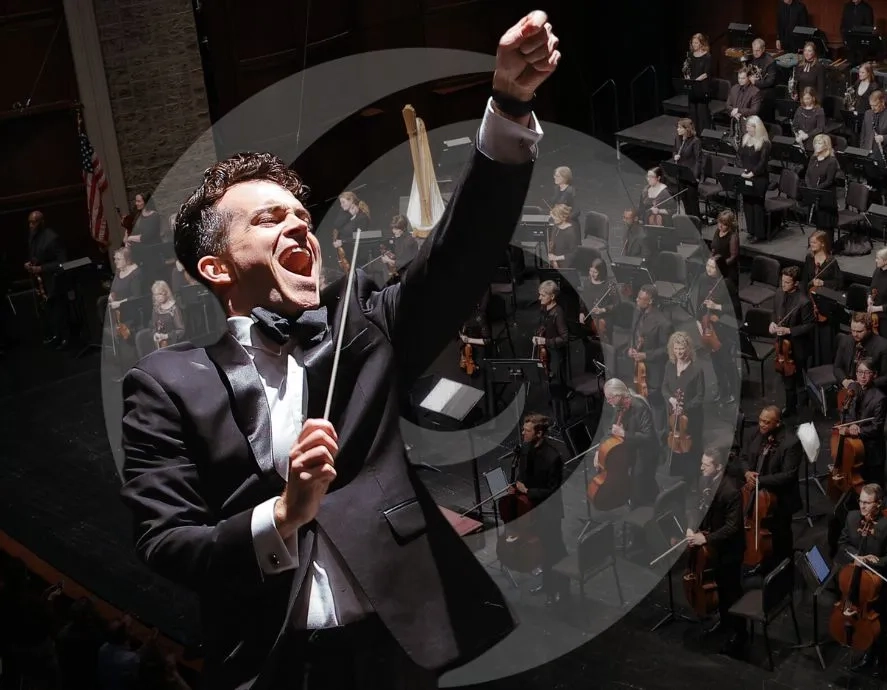
Concert Hall Series
Saturday performances at 7:30 pm
Sunday at 3:00 pm
Opening Night: Beethoven’s Ninth
October 5 & 6
Grieg’s Piano Concerto
November 23 & 24
Tchivzhel Conducts Tchaik 4
January 25 & 26
Duke Ellington’s The River
March 1 & 2
Jacqueline Tso plays
Bruch’s Scottish Fantasy
April 5 & 6
Beethoven and Brazil
May 10 & 11
Gunter Theatre Series
Performance start times vary
Peter and the Wolf
November 9 & 10
The Marriage of Figaro
February 15 & 16
Movers, Shakers, and Noise-Makers
March 22 & 23
Bach-Inspired with Violist Kathryn Dey
May 24 & 25
Special Events
Holiday at Peace
Peace Concert Hall
December 6 at 7:00 pm
December 7 at 1:00 & 7:00 pm
December 8 at 2:00 pm
Harry Potter and the Prisoner of Azkaban™ in concert
Peace Concert Hall
January 11 at 1:00 pm and 7:00 pm
January 12 at 2:00 pm
Star Wars: The Empire Strikes Back in Concert
May 4 at 7:00 pm
Bon Secours Wellness Arena
Music at Hotel Hartness
A luxe chamber music experience in a beautiful space.
Performances at 7:00 pm
Dracula! with Special Guest Dacre Stoker
October 23
Musical Landscapes
April 23
Music in the Gray Loft
Enjoy lunch or wine with a friendly, casual chamber music experience.
Performances at 12:00 and 5:30 pm
Dracula! with Special Guest Dacre Stoker
October 24
Musical Landscapes
April 24
Details and tickets available at greenvillesymphony.org
